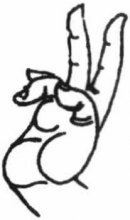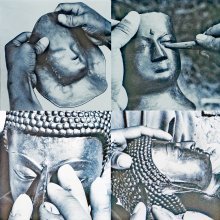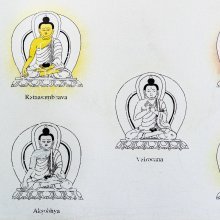Thumb: 2 definitions
Introduction:
Thumb means something in Hinduism, Sanskrit. If you want to know the exact meaning, history, etymology or English translation of this term then check out the descriptions on this page. Add your comment or reference to a book if you want to contribute to this summary article.
Images (photo gallery)
In Hinduism
Shilpashastra (iconography)
Source: Shodhganga: Elements of Art and Architecture in the Trtiyakhanda of the Visnudharmottarapurana (shilpa)The Thumb Measurements (in portraits) follows the principles of ancient Indian Painting (citra), according to the Viṣṇudharmottarapurāṇa, an ancient Sanskrit text which (being encyclopedic in nature) deals with a variety of cultural topics such as arts, architecture, music, grammar and astronomy.—In the third part of the Viṣṇudharmottarapurāṇa, chapters 35th to 43rd are dedicated to the Painting of different portraits of different kinds of men and women. The measurement of some minor limbs are also furnished in the Viṣṇudharmottarapurāṇa. The thumb should be three aṅgulas in length. The measurements of nail are also discussed in the Viṣṇudharmottarapurāṇa. The nail of thumb is one forth thinner than the breadth. The nail of the index finger is half of that and the remaining nails are one eighth of the nail of the thumb.

Shilpashastra (शिल्पशास्त्र, śilpaśāstra) represents the ancient Indian science (shastra) of creative arts (shilpa) such as sculpture, iconography and painting. Closely related to Vastushastra (architecture), they often share the same literature.
Yoga (school of philosophy)
Source: ORA: Amanaska (king of all yogas): A Critical Edition and Annotated Translation by Jason BirchThe Thumbs are denoted by the Sanskrit term Aṅguṣṭha, according to the Mataṅgapārameśvaratantra (Mataṅgapārameśvara’s Yogapāda) verse 2.23-27.—In later Tantras, various details [such as fixing the eyes on some object] often preceded the verses on the seated postures, thereby indicating that the position of the hands, torso and gaze was ancillary to all of the prescribed postures. In the Mataṅgapārameśvara, these postural ancillaries [making use of the thumbs] constitute what they call a karaṇa, and when it is combined with a seated pose, the Yogin’s posture becomes just as complicated as any seated pose described in later medieval yoga texts.

Yoga is originally considered a branch of Hindu philosophy (astika), but both ancient and modern Yoga combine the physical, mental and spiritual. Yoga teaches various physical techniques also known as āsanas (postures), used for various purposes (eg., meditation, contemplation, relaxation).
See also (Relevant definitions)
Starts with (+19): Thumba, Thumbai, Thumbaipoo, Thumbari, Thumbe, Thumbe hoo gida, Thumbe soppu, Thumbhul, Thumbi, Thumbrashtagam, Tumpa, Tumpai, Tumpaimalai, Tumpaittinai, Tumpaiyan, Tumpalai, Tumpalainam, Tumpalamaniyam, Tumpamatai, Tumparam.
Full-text (+486): Angushtha, Vitasti, Pradesha, Angula, Chotika, Apasalavi, Angushthya, Padangushtha, Balakhilya, Vedhasa, Paitra, Vriddhanguli, Vriddhangushtha, Makara, Anguttha, Samtosha, Pitritirtha, Valakhilya, Angushthamatra, Gokarna.
Relevant text
Search found 147 books and stories containing Thumb; (plurals include: Thumbs). You can also click to the full overview containing English textual excerpts. Below are direct links for the most relevant articles:
The Agni Purana (by N. Gangadharan)
Chapter 24 - Mode of constructing the sacrificial pit and the oblations unto fire
Chapter 25 - Worship regarding Vāsudeva, Saṅkarṣaṇa, Pradyumna and Aniruddha
Chapter 310 - The narration of the spell relating to Tvaritā
Parama Samhita (English translation) (by Krishnaswami Aiyangar)
Chapter 14 - Mystic signs (mudrā)
Chapter 5 - The prescribed disposal of articles of worship (dravya-vidhāna)
Abhinaya-darpana (English) (by Ananda Coomaraswamy)
Chapter 26 - Hands denoting Animals
Chapter 13 - Twenty-four Combined Hands
Dhammapada (Illustrated) (by Ven. Weagoda Sarada Maha Thero)
Verse 422 - The Story of Angulimāla the Fearless < [Chapter 26 - Brāhmaṇa Vagga (The Brāhmaṇa)]
Vishnudharmottara Purana (Art and Architecture) (by Bhagyashree Sarma)
2.2. (d): Hand Gestures for Daśāvatāra < [Chapter 3 - Drama and Dance]
2.2. Hand Postures (a): Asaṃyukta-hasta < [Chapter 3 - Drama and Dance]
7(a): Portrait of Men and Women < [Chapter 5 - Painting and Image Making]
Lalitopakhyana (Lalita Mahatmya) (by G.V. Tagare)
Related products



